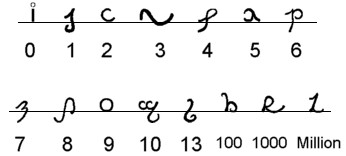First, we'll go over how to say the numbers out loud, and then after that we'll cover how to actually write numbers down on paper using the Almalinian writing system.

If you're familiar with the way Esperanto counting works, this should be very simple for you. If you're not so fortunate, the counting system, though different from the way that we do it, is still easy (easier than in English, actually), and you don't have anything to worry about.
Suppose you want to say the number 20. Well, what is 20? Imagine 20 as being two tens put together; after all, that's really what it is: 2 x 10 = 20. So, rather than having a completely different word for "two tens" like in English, you simply write two-ten: dunyar (dun is 2; yar is 10). You can create thirty in a similar way. Using the list below, what do you think thirty would be?
There are only two small exceptions to this: Firstly, if you want to say a number between 11-20 (except 13, which we'll get to in a moment), you just say "ten number," and not "one-ten number". Thus, 15 is yar celth and not nielyar celth. The second exception is that 13 has its own number, separate from the rest. The reason for this is that in Almalinian history, thirteen has been associated with evil things, and so the Almalinians don't want to "pollute" their entire number system by treating such an evil number as 13 like all the other numbers. Therefore, thirteen is guc and not yar prin. In fact, if you said yar prin to an Almalinian, you could be putting your life in jeopardy(!), and so make sure you get it right.
The hundreds, thousands, and millions work the same way. 500 is simply five hundreds, so you would write celthfent. So, now that you've got the hang of it all, let's do a big example. Figure out how you would say "2, 781, 431".
The answer: dunrum, temfent hemyar niel quel, lorfent prinyar niel. If you look at it, you might see that I handled each number at a time: the 2 represents two millions, so I wrote just that. For the next number, 7, I had to think, "Okay, this number is representing seven hundreds," and then I wrote it down. For the 8, I had to realize that it represented eighty, which I then changed to "eight tens" in my head. Another way of thinking about this number is like this:
2 000 000 + (700 + 80 + 1) thousand + (400 + 30 + 1).

Once you understand how to actually write the numbers out like above, you're ready to write the numbers as a true Almalinian would. It's actually just the same thing as you did above, except that now you're substituting a symbol in for each of the words that were given in the list above. Here's a handy chart of the symbols to use:

Here's how you would write 1492
with the Almalinian number system:
